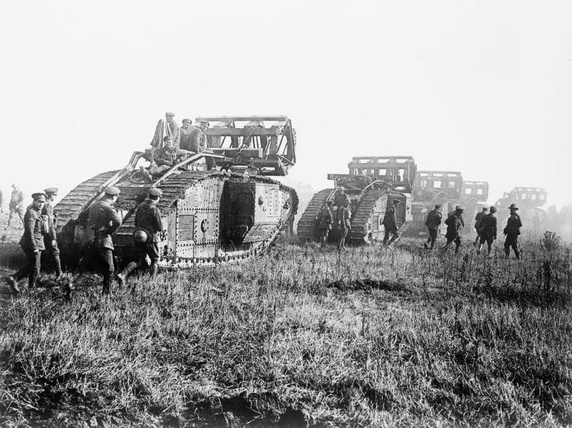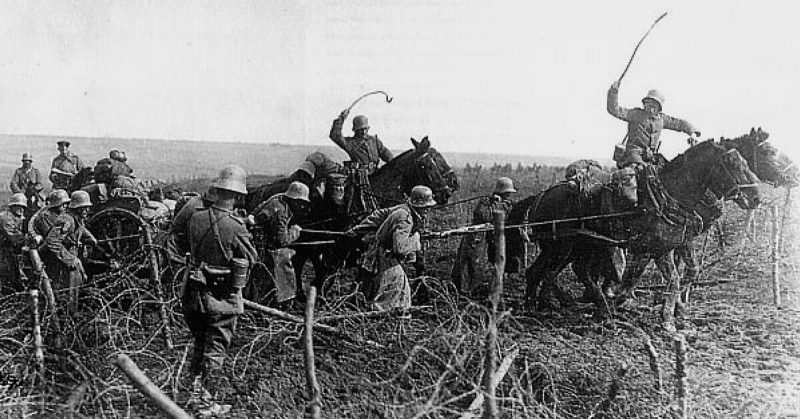Although they only arrived in the final year of the First World War, the Americans made their presence felt. The volume of manpower and resources they provided was decisive in bolstering the Allied lines. More so, there were times when American troops did the hardest and most resolute fighting in the latter part of the war.
One of those occasions was the Battle of the Ourcq.
The Germans in Retreat
By late July 1918, the Germans were in retreat. Their spring offensive had brought them close to winning WWI, but it had not been enough. The Allied lines had held, and the Germans were now being pushed back.
They implemented a fighting retreat as they sought to withdraw without suffering terrible losses. Enormous amounts of supplies had been brought up to support the spring offensive. The troops had to buy time for these to be extracted.
On the night of July 26, German forces pulling back from the Marne Salient reached the River Ourcq. There they formed a line on the River’s far bank, hoping to slow advancing American forces while their comrades withdrew from elsewhere in the salient.
A Defensive Position
The Germans had a knack for defensive combat throughout the war. They chose good ground for their positions, and they had dug strong, deep defenses.
Their stand on the Ourcq was no exception. The River was swollen with torrential rain, making it eight feet deep and 40 feet across. The bridges across it had been decimated. A crossing would be difficult and expose American troops to German gunfire.
Two hills on the east bank of the river – Hill 212 and Hill 184 gave the Germans high ground from which to watch and fire upon the enemy. Together with the village of Sergy, the hills gave them good defensive positions.
The Americans Advance
On July 28, the Americans began their attack across the Ourcq. Three divisions – the 3rd, 28th, and 42nd – were to advance early in the morning and cross the river.
The 3rd managed it, easily taking Ronchères.
The 28th were reliant on French guides, who turned up late. They missed their chance to set out early and came under heavy fire from German troops at La Motte Farm. It was past 1500 before they got across the river. Then heavy gunfire from the Germans on Hill 212 and north of Ronchères forced them to halt. Only a quarter of a mile from the River, they stopped and dug in.
Fighting for Sergy
The 42nd also suffered from heavy German fire as they advanced. At first, they were forced back, but by 1030 they were across the Ourcq. They reached the edge of Sergy, but once again came under devastating gunfire. German spotter planes were directing the attention of artillery onto them. From Hill 212, the Germans rained death down upon the Americans.
The German 4th Guards Division made the most of this. Launching a counter-attack, they drove the Americans out of Sergy.
Not to be beaten, the Americans launched a fresh attack, once again gaining a foothold in the village. Throughout the day, each side launched attacks and counter-attacks. By 2000 that evening, the Americans had finally secured ground there.
Counter-Attacks
As dusk fell, the fighting became less intense, but it was far from a peaceful night. Both sides harried each other in the darkness, determined not to let the enemy rest.
The next day was one of exhausting back-and-forth counter-attacks.
It began as dawn broke. A heavy German bombardment of the 42nd Division troops in Sergy was followed by a fresh attack by the 4th Guards. The Americans were once again driven from the bullet-riddled village.
This time, the entire 42nd Division hit back. They made advances at Sergy, Meurcy Farm, and Seringes-et-Nesles. By noon, Sergy was finally in American hands. By the end of the day, they had taken Hill 184, significantly weakening the German line.
Not everyone was so successful. The 3rd Division tried to take Meunière Wood north of Ronchères but were driven back.
That night, the battered 3rd Division were replaced by the 32nd. The 42nd, weary from the bitter fighting to take Hill 184, remained on the line. They were reinforced by two infantry battalions from the 4th Division.

Grinding On
Throughout the night, German artillery continued to bombard the Americans on the banks of the Ourcq. It was a taste of what was to come.
For the next two days, the Germans poured everything they had into the fight. Artillery bombardments, machine-gun fire, and persistent counter-attacks made the Americans bleed for every inch of ground they took.
They did gain ground. With attack after attack, the stubborn American forces chipped away at the German lines. Every time they gained ground, they clung to it resiliently, unwilling to let the Germans retake what they had fought so hard for.
It was a slow, grinding battle in which many men died. Progress was being made. The German position was weakening.
Taking the Salient
At last, on August 1, the German gunfire began to desist. Their positions overlooking the River Ourcq had all been taken by the Americans. The high defensive terrain was out of their hands. Fundamentally weakened, they had no choice. It was time for them to withdraw.
Fresh American troops moved up, relieving the bloodied 42nd Division. Then the Americans advanced again. For the next five days, they faced only light resistance, as the Germans undertook a swift fighting retreat.
By August 6, the Marne Salient had been retaken. The Germans were well and truly on the defensive. Ourcq had been a painful experience for the Americans but a vital success for the Allied cause.
Source:
Martin Marix Evans (2002), Over the Top: Great Battles of the First World War.
